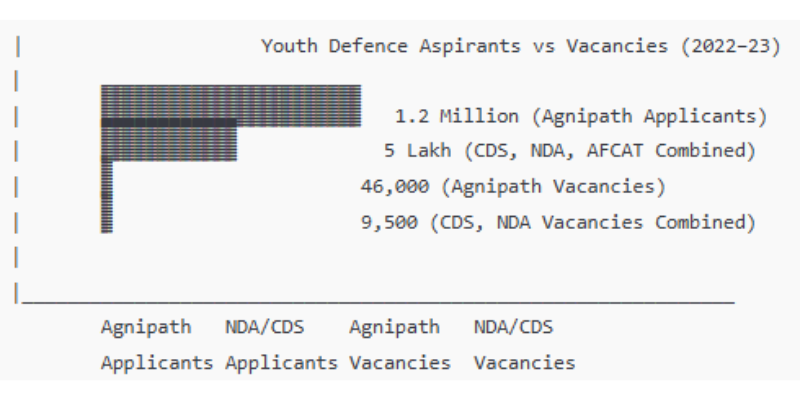Introduction
India, which has more than 65% of its people below the age of 35 years, is among the youngest countries in the world. In addition to a demographic dividend, India is a strategic dividend too, beginning with and above everything, national security. India’s defense prowess and security can be redefine by India’s youth, which is filled with dynamism, patriotism, and aim. Their contribution to the Indian Armed Forces—Army, Navy, Air Force—and defence alliance services is more relevant, not just as numbers but in quality, imagination, and dedication.
Youth and the Armed Forces: A Powerful Alliance
Indian Defence Forces have been the most sought-after career choice for the majority of youth Indians, and ask why not. Defence forces service is the pinnacle of honour, responsibility, and dedication. The Ministry of Defence Annual Report 2023 has reported that the age structure of an Indian Army soldier is a median age of 26 years, indicating the absolute predominance of youth in defence forces.
The newly launched Agnipath Scheme (2022) is a true testament to the government’s confidence in youths. Young people aged between 17.5 and 21 years are hired for four years under the scheme. During the first year of the scheme’s implementation, the scheme received more than 1.2 million applications for only 46,000 vacancies, a testament to the sheer eagerness of youths to serve the nation.
Young Peoples Opportunities of Joining Defence Recruitment Schemes of Armed Forces
National Defence Academy (NDA): Age group 16.5-19.5 years.
Combined Defence Services (CDS): Graduates in the age group of 19-25 years.
Technical Entry Scheme (TES): For science stream students at 10+2 level.
BTech Cadet Entry Scheme by Indian Navy and AFCAT of the Air Force are also worth considering opportunities.
Paramilitary and Police Forces: The youth also join the paramilitary forces such as the CRPF, BSF, ITBP, CISF, and SSB, which are key to the internal security of the country.
Research and Technology Assignments: Technically trained youth are deployed in DRDO, ISRO, BEL, and other defence R&D establishments, offering state-of-the-art technology development.
Territorial Army and NCC:
Territorial Army offers opportunity to the youth to serve voluntarily part-time.
The National Cadet Corps (NCC) trains over 13 lakh cadets annually, instilling discipline and the willingness to serve the armed forces.
Numbers That Tell A Thousand Words
13 lakh+ youth trained annually through NCC schemes.
4 lakh applications annually for NDA and CDS together.
India boasts over 14 lakh active strength, and over 2 lakh youth are placed annually in armed and paramilitary forces.
72% of Indian youth, in a recent survey, said they would be honored to serve the armed forces, an indicator of extremely high national pride.
Youth Challenges in Defence Recruitment
Despite the enthusiasm, there are challenges:
Fewer vacancies than tough competition has a tendency to disillusion.
There is not sufficient awareness of different jobs and means of entry.
Physical and psychological preparation falls behind in schools and colleges.
Short-service personnel such as Agniveers continue to be a post-retirement planning problem even when resettlement schemes are being implemented.
Youth as Drivers of Change
Youth defence personnel introduce:
Technological Prowess: Gen Z is more technologically adept and hence better equipped to handle cyber defence, drone warfare, and virtual warfare.
Flexibility and Innovation: Young people can be made agile in no time, innovate in the battlefield, and shatter obsolete procedures.
National Integration: Since the recruits come from all states and societies, the army is a wonderful unifier.
Encouraging Youth Participation in Defence: The Future
NCC and NSS should be developed at school and college levels so that discipline and awareness are inculcated from the first days.
Establish Defence Career Counselling Cells in schools and colleges.
Drive social media and storytelling to another level to beam inspiring stories of young officers and soldiers.
Improve defence entrepreneurship and engineering and technology graduates start-ups to create indigenous capability in “Atmanirbhar Bharat”.
Improve security and financial health at retirement if short-term employment is resorted to.
|
Entry Route |
Age Group |
Eligibility |
Targeted Forces/Role |
|
NDA (National Defence Academy) |
16.5 – 19.5 |
10+2 Pass |
Army, Navy, Air Force (Officer) |
|
CDS (Combined Defence Services) |
19 – 25 |
Graduate |
Army, Navy, Air Force (Officer) |
|
Agnipath Scheme |
17.5 – 21 |
10th / 12th Pass |
Army, Navy, Air Force (Soldier) |
|
Technical Entry Scheme (TES) |
16.5 – 19.5 |
10+2 with PCM |
Army (Engineering) |
|
NCC Special Entry |
Varies |
NCC ‘C’ Certificate |
Direct SSB Entry (Officer) |
|
Paramilitary Forces |
18 – 25 |
10th / 12th / Graduate |
BSF, CRPF, CISF, ITBP, etc. |
|
Territorial Army |
18 – 42 |
Graduate + Civilian Job |
Part-time Defence Reserve |
|
DRDO/ISRO/BEL |
21 – 30 |
Engineering Graduates |
R&D and Tech Development |
Conclusion
India is at the cusp of changing its international role—there is no desire to be a commercial behemoth but a secure, strong nation. India’s youth are its strength. Their contribution to defence—direct contribution, technological innovation, and support—cannot be overstated. Indian defence’s destiny is to empower its youth, not to serve but to lead, defend, and change. With sufficient opportunity, guidance, and encouragement, tomorrow’s heroes can be today’s youth.
Prepared by
Bura Vijay Kumar
School of Computer Science and Artificial Intelligence, SR University
Ananthasagar, Warangal.
vijaykumar.bura@gmail.com





